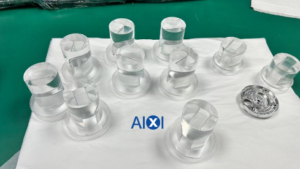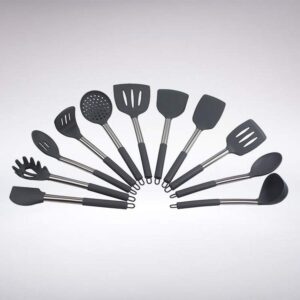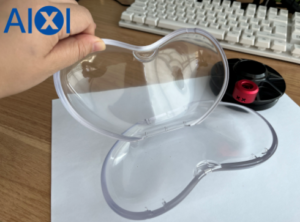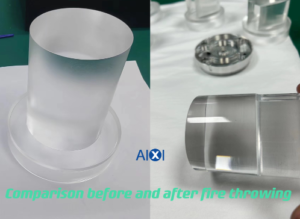Acrylic and polycarbonate are very similar in many ways, but there are some important differences. So we often choose the best material based on factors such as lead time and cost, ease of processing, and the specific application for which the material is suitable.
Characteristics of Acrylic and Polycarbonate
| characteristic | acrylic acid | polycarbonate |
| Strength and transparency, an excellent alternative to standard glass | Tough and impact-resistant, making it an application that requires transparency and higher durability | |
| Casting acrylic acid is usually better than extrusion acrylic acid, extrusion is more likely to crack or chip during processing | Polycarbonate has toughness and impact resistance, and is more suitable for machining, especially for CNC milling | |
| Tool path strategies need to be carefully selected to avoid part fragmentation | When processing polycarbonate, the sharpness of the cutting tool is still important, because if too much heat is generated during processing, the polycarbonate plate may melt | |
| Acrylic resins are not very heat resistant, so sharp cutting tools must be used to obtain a smooth surface finish | Since polycarbonate is less prone to breakage than acrylic, it tends to be easier to process and allows for the use of a more standard tool path strategy | |
| The low melting point of acrylic means that a lower cutting feed rate than other plastics also needs to be used during processing, because higher feed rates generate more friction and heat and can damage parts | Since the operating temperature range is higher, more aggressive strategies can be used with less likelihood of causing problems, potentially saving time and money | |
| Acrylic acid can be stored in the refrigerator before processing to ensure that it stays as cold as possible | ||
| common point | ||
| It’s all lightweight, transparent plastic | ||
| They are lightweight, machinable and have unique characteristics | ||

Transparency: Acrylic allows up to 92% of light to pass through, making it more transparent than some grades of glass and most other thermoplastics. It can also be tinted without sacrificing transparency, and many opaque acrylic parts can be made.
Strength: Acrylic is stronger and more impact-resistant than glass. Most grades of acrylic are four to eight times stronger than glass.
Environmental Resistance: Acrylic is naturally resistant to scratches, weathering and UV radiation, making it ideal for outdoor applications.
Chemical Resistance: Acrylic is resistant to a wide range of chemicals, including alkalis, detergents, cleaners and dilute mineral acids.
Compatibility with coatings: Acrylic parts can be coated with antistatic, hardcoat or anti-glare layers to improve their surface quality, extend their service life and ensure they meet specific requirements.
Affordable: Despite acrylic’s strength, durability, and clarity, its manufacturing and CNC machining costs are still relatively low. At least 35% cheaper than polycarbonate.
Color: Acrylic is available in a variety of colors.
Extremely high biocompatibility: making it a good choice for bone implants, dentures or other skin-contact applications.
Hygroscopicity: Acrylic has low hygroscopicity, so it maintains its dimensions when used outdoors.
Disadvantages of CNC acrylic:
- More prone to cracking and splintering, resulting in increased processing difficulty. To reduce chatter and achieve high-quality cuts, acrylic parts should be processed using tools with short groove lengths and a cutting depth of approximately half the diameter of the drill bit.
- Acrylic is not the best choice for food containers that are exposed to high temperatures (such as dishwashers or microwaves) because acrylic parts can only maintain their dimensions at temperatures of 65°C or will begin to soften
- The material is prone to deformation during the manufacturing process as it loses structural integrity and begins to melt at temperatures in excess of 160°C. To avoid the risk of melting and achieve a high quality surface finish, use appropriate feed speeds and passes. Depth is crucial.

Transparency: Polycarbonate is a naturally clear thermoplastic that transmits light as efficiently as glass, making it ideal for lenses, lighting, and bulletproof glass. Like acrylic, polycarbonate can be tinted without sacrificing transparency.
Variety: There are a variety of polycarbonate formulations on the market, including glass-filled and FDA-compliant variants, so it’s easy to find a product that meets your project needs.
Strength and Impact Resistance: Polycarbonate has a tensile strength approximately 200 times that of glass and is highly impact resistant. Therefore, it is often used in bulletproof glass and protective gear.
Shrinkage and Dimensional Stability: Polycarbonate maintains its size under most conditions and has a low shrinkage rate of 0.6 – 0.9%.
Environmental Resistance: Polycarbonate is naturally resistant to UV radiation and can withstand varying humidity levels and fluctuating temperatures, making it an excellent material for outdoor applications and eyewear.
Chemical resistance: Polycarbonate is resistant to a wide range of chemicals, including dilute acids, oils, waxes, aliphatic hydrocarbons, alcohols and greases.
Hygroscopicity: Polycarbonate is slightly less hygroscopic than acrylic.
Compatibility with coatings: Like acrylic, polycarbonate components can be coated with antistatic, hardcoat and anti-glare layers. Polycarbonate is also compatible with UV and anti-fog layers.
High machinability: Since polycarbonate is very durable and heat-resistant, it is easier to CNC machine than acrylic.
Disadvantages of CNC polycarbonate:
- High cost and prone to dents.
- Since polycarbonate scratches easily, it is more likely to require finishing, and this is complicated by the fact that only certain finishing processes, such as vapor polishing and coating, are suitable for polycarbonate parts.
- Polycarbonate parts are also prone to dents or voids in thicker sections. To prevent this from happening, it’s a good idea to break down thicker components into smaller, thinner parts for later assembly. It’s easy to remember this tip by keeping the cost in mind – machining thick parts from a single piece of polycarbonate is generally more expensive than machining smaller parts due to raw material costs and machining time. Finishing Options for Acrylic and Polycarbonate There are a variety of finishing options available for acrylic and polycarbonate, some of which can help your parts look and feel ready for end-use applications or even improve clarity.
- Polycarbonate is not as transparent as acrylic
Surface treatment after CNC machining of acrylic and polycarbonate:
Sandblasting: Sandblasting is an economical surface preparation method that creates a uniform appearance, often leaving a matte or satin finish, and is effective in removing tool marks and surface blemishes.
Vapor Polishing: This finishing option uses solvent vapor to transform a matte or opaque surface into a smooth, high-gloss, or optically clear surface. Vapor polishing is typically used on parts where a rough surface is unacceptable or where transparency is critical.
Fire polishing: It is a surface treatment technology that melts and polishes the acrylic surface through high-temperature flames, which can effectively improve the smoothness and gloss of the workpiece surface.
Application:
Acrylic is a popular material in the automotive, construction, and aerospace industries, often used in items such as dry boxes, lenses, radiation shields, and dryers. Additionally, its clarity, strength, and high impact resistance make it a great alternative to glass, and you can find it commonly used in greenhouses, aquariums, terrariums, safety barriers, and more.
Like acrylic, polycarbonate is popular in the automotive, aerospace, and construction industries, but its heat resistance and strong dimensional stability make it very popular in the medical industry, as polycarbonate parts can withstand limited Autoclave and irradiation sterilization. Among its more common applications, polycarbonate is often used in point-of-purchase retail display cases, face shields, construction sample displays, clear manifolds, bullet-resistant windows, and more.
Above we briefly discussed the advantages and disadvantages of acrylic and polycarbonate, and their products can be found everywhere in daily applications. But beyond that, many other CNC machined materials may be compatible with your part’s design and intended application, and choosing the right one can be a specialized and complex process. Fortunately, at AIXI our dedicated and experienced team of engineers can provide you with relevant CNC material manufacturing and application expertise to ensure production runs as smoothly and cost-effectively as possible. If you have any questions, please contact us immediately.

 Deutsch
Deutsch Français
Français 日本語
日本語 Español
Español

